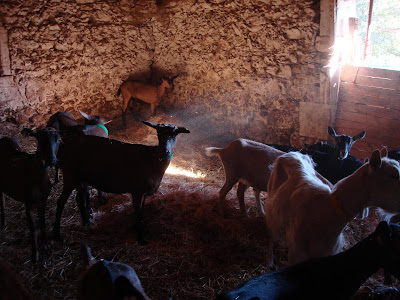
As I stepped out of my car the powerful musky scent of the billy goat hit me forcefully. Yes, rutting beasts make their presence known. Apparently bears are far smellier, but this billy goat's scent carries far. Aurelie was in the barn, and my arrival was perfectly timed. The goats had charged eagerly up to their milking spots, jumping over each other, skipping a spot here and there, and she was up there trying to disentangle them and get them straight. I was able to jump in and help. I haven't actually spent that much time with the animals beyond milking them. As Aurelie doesn't take them out for long walks, and as I've not been here as much as I would like. But at least I am at ease with them, and can handle a couple that get loose without fear or worry.

It's nearly mid-November already. The goats are giving less and less milk. Most have been gotten with kid by the billy goat now. Aurelie is milking every day, but making cheese only every other day. Thus the labor in the laboratory was relatively light today.

Today, rather than do my normal routine of lots and lots of cleaning and scrubbing, I was able to be just with the cheese. I was able to work on my flipping skills. This was the second flip, not the first. Which means that the cheese filled about a third of the mold, having drained already for more than a day. However, I did it well nonetheless, so I was pleased. I wasn't able to get the technique using my thumb to work, no matter than Aurelie showed me again, and that Paul Pierre had emphasized that this was the proper technique. I've still the image of another goat cheese maker engrained on my brain, Claudine for those of you who've visited with me, and her hand movements are easier for me to replicate. She would tip out the cheese higher up on her palm, flip it down to her fingers and then plop it back in the mold. Clearly, she had mastered this over 30 years of activity, and did it quickly and cleanly. I found this manoeuver far easier for me, and after a couple of tries, was able to do it relatively smoothely, quickly and cleanly, no bits left on the sides, no unsightly finger prints.
A couple hundred cheeses later I switched to pouring out the set curd into the molds for the next batch of cheeses. This is the easy part for me now. I pour off the whey and the more fuzzy skum that forms on the top during the initial fermentation, then I comb my fingers through the curd lightly, to homogenize it a bit (the curd in the middle is denser than that on the sides, and thus makes a different cheese), and then I took the large cup and started pouring it over the molds and the mold holder. No need to over fill the molds with this dense end-of-season curd.
Once finished, I helped clean up these tools, and then hosed down, scrubbed and squeegeed the floor. Then off to lunch with Isabelle and Paul Pierrre where I was served calve's tongue -- a first for me!-- with a lovely sauce of capers, mustard, vinegar, oil, and chopped fresh parsley. In the true sauce a hard boiled egg is separated into yolk (which gets blended with the mustard and oil) and minced white which is added to the sauce. I'm afraid I've forgotten the name of this sauce, but will try to get it in the near future. It begins with a C...
In any case, lunch was surprisingly delicious and tender, the tongue having been cooked for over an hour in the pressure cooker with leeks and carrots and good things in the bouillon. Simple baked potatoes accompanied. It was quite a good peasant feast. Hmmm. I wonder if I served tongue to my boys if they'd have any clue? Best to slice it up first I think, as visually, it is an odd thing to look at, and requires peeling before slicing and serving. They might take a look at it and flee the table. Or not.
No comments:
Post a Comment